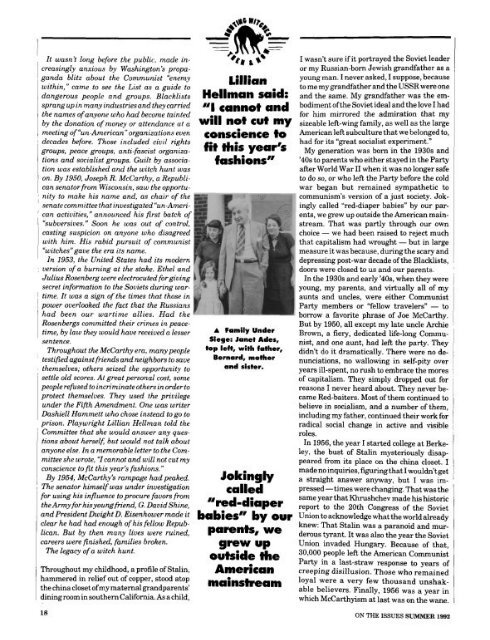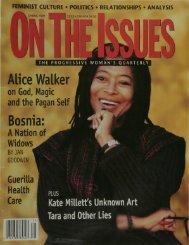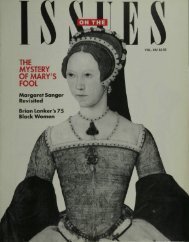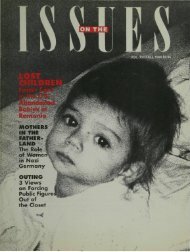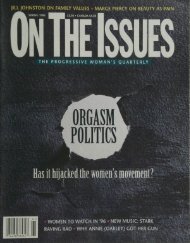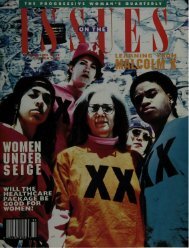300 Years & Counting 1H KILLS - On The Issues Magazine
300 Years & Counting 1H KILLS - On The Issues Magazine
300 Years & Counting 1H KILLS - On The Issues Magazine
You also want an ePaper? Increase the reach of your titles
YUMPU automatically turns print PDFs into web optimized ePapers that Google loves.
It wasn't long before the public, made increasinglyanxious by Washington's propagandablitz about the Communist "enemywithin," came to see the List as a guide todangerous people and groups. Blacklistssprang up in many industries and they carriedthe names of anyone who had become taintedby the donation of money or attendance at ameeting of "un-American" organizations evendecades before. Those included civil rightsgroups, peace groups, anti-fascist organizationsand socialist groups. Guilt by associationwas established and the witch hunt wason. By 1950, Joseph R. McCarthy, a Republicansenator from Wisconsin, saw the opportunityto make his name and, as chair of thesenate committee that investigated "un-Americanactivities," announced his first batch of"subversives." Soon he was out of control,casting suspicion on anyone who disagreedwith him. His rabid pursuit of communist"witches"gave the era its name.In 1953, the United States had its modernversion of a burning at the stake. Ethel andJulius Rosenberg were electrocuted forgivingsecret information to the Soviets during wartime.It was a sign of the times that those inpower overlooked the fact that the Russianshad been our wartime allies. Had theRosenbergs committed their crimes in peacetime,by law they would have received a lessersentence.Throughout the McCarthy era, many peopletestified against friends and neighbors to safethemselves; others seized the opportunity tosettle old scores. At great personal cost, somepeople refused to incriminate others in order toprotect themselves. <strong>The</strong>y used the privilegeunder the Fifth Amendment. <strong>On</strong>e was writerDashiell Hammett who chose instead to go toprison. Playwright Lillian Hellman told theCommittee that she would answer any questionsabout herself, but would not talk aboutanyone else. In a memorable letter to the Committeeshe wrote, "I cannot and will not cut myconscience to fit this year's fashions."By 1954, McCarthy's rampage had peaked.<strong>The</strong> senator himself was under investigationfor using his influence to procure favors fromthe Army for his young friend, G. David Shine,and President Dwight D. Eisenhower made itclear he had had enough of his fellow Republican.But by then many lives were ruined,careers were finished, families broken.<strong>The</strong> legacy of a witch hunt.Throughout my childhood, a profile of Stalin,hammered in relief out of copper, stood atopthe china closet of my maternal grandparents'dining room in southern California. As a child,LillianHellman said:"I cannot andwill not cut myconscience tofit this year'sfashions''A Family UnderSiege: Janet Ades,lop left, with father,Bernard, motherand sister.Jokinglycalled"red-diaperbabies" by ourparents, wegrew upoutside theAmericanmainstreamI wasn't sure if it portrayed the Soviet leaderor my Russian-born Jewish grandfather as ayoung man. I never asked, I suppose, becauseto me my grandfather and the USSR were oneand the same. My grandfather was the embodimentof the Soviet ideal and the love I hadfor him mirrored the admiration that mysizeable left-wing family, as well as the largeAmerican left subculture that we belonged to,had for its "great socialist experiment."My generation was born in the 1930s and'40s to parents who either stayed in the Partyafter World War II when it was no longer safeto do so, or who left the Party before the coldwar began but remained sympathetic tocommunism's version of a just society. Jokinglycalled "red-diaper babies" by our parents,we grew up outside the American mainstream.That was partly through our ownchoice — we had been raised to reject muchthat capitalism had wrought — but in largemeasure it was because, during the scary anddepressing post-war decade of the Blacklists,doors were closed to us and our parents.In the 1930s and early '40s, when they wereyoung, my parents, and virtually all of myaunts and uncles, were either CommunistParty members or "fellow travelers" — toborrow a favorite phrase of Joe McCarthy.But by 1950, all except my late uncle ArchieBrown, a fiery, dedicated life-long Communist,and one aunt, had left the party. <strong>The</strong>ydidn't do it dramatically. <strong>The</strong>re were no denunciations,no wallowing in self-pity overyears ill-spent, no rush to embrace the moresof capitalism. <strong>The</strong>y simply dropped out forreasons I never heard about. <strong>The</strong>y never becameRed-baiters. Most of them continued tobelieve in socialism, and a number of them,including my father, continued their work forradical social change in active and visibleroles.In 1956, the year I started college at Berkeley,the bust of Stalin mysteriously disappearedfrom its place on the china closet. Imade no inquiries, figuring that I wouldn't geta straight answer anyway, but I was impressed—times were changing. That was thesame year that Khrushchev made his historicreport to the 20th Congress of the SovietUnion to acknowledge what the world alreadyknew: That Stalin was a paranoid and murderoustyrant. It was also the year the SovietUnion invaded Hungary. Because of that,30,000 people left the American CommunistParty in a last-straw response to years ofcreeping disillusion. Those who remainedloyal were a very few thousand unshakablebelievers. Finally, 1956 was a year inwhich McCarthyism at last was on the wane.18ON THE ISSUES SUMMER 1992


